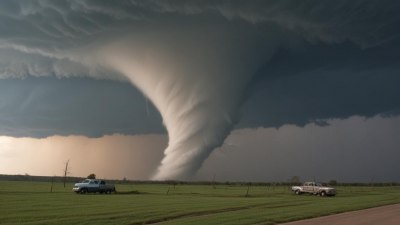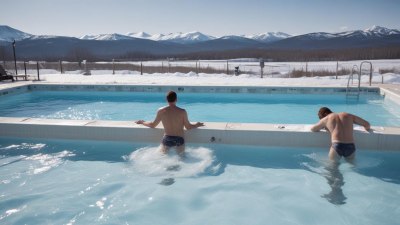Why We Feel Wind Chill Even If the Temperature Stays the Same
Discover why wind chill makes us feel colder even when the temperature remains unchanged and how wind affects human perception.

Image created with Flux Schnell
When stepping outside on a chilly day, you might notice that it feels much colder than the thermometer indicates, especially when the wind is blowing. This phenomenon is commonly known as wind chill, a term that describes the perceived decrease in air temperature felt by the body due to the flow of air. But why do we feel colder when the wind picks up, even if the actual temperature stays the same? To understand this, we need to examine the interaction between our bodies, the environment, and the science behind heat transfer.
Understanding Temperature and Human Perception
Temperature is a measure of thermal energy in the air, typically measured by a thermometer shielded from wind and direct sunlight to ensure accuracy. However, this number alone does not capture how our bodies actually experience the weather. Human perception of temperature is influenced by several factors, including humidity, sunlight, clothing, and notably, wind.
Our bodies constantly produce heat through metabolic processes, which is essential for maintaining a stable internal temperature of approximately 37 degrees Celsius (98.6 degrees Fahrenheit). To prevent overheating, this heat dissipates into the surrounding environment. The rate at which heat is lost depends on the temperature difference between our skin and the surrounding air, as well as the conditions of the external environment.
Heat Loss Mechanisms: Radiation, Conduction, Convection, and Evaporation
Heat transfer from the human body occurs primarily through four mechanisms: radiation, conduction, convection, and evaporation. Radiation involves the emission of infrared heat from the body into cooler surroundings. Conduction is the direct transfer of heat through contact with solid objects, like sitting on a cold bench. Convection, however, involves the movement of air or water molecules around the body, which plays a crucial role in the wind chill effect. Evaporation comes into play when our sweat vaporizes, cooling the skin.
Among these, convection is heavily influenced by wind. Under calm conditions, the thin layer of air immediately adjacent to the skin, known as the boundary layer, acts as an insulating shield that reduces heat loss. However, when wind is present, this boundary layer is disturbed and continuously replaced with cooler air, accelerating heat loss.
The Science Behind Wind Chill
Wind chill measures how cold it feels on exposed skin due to the combined effects of air temperature and wind speed. The phenomenon originates from the enhanced cooling effect that wind has on the skin. Even though the air temperature remains constant, increasing wind speed removes the warm air surrounding the body more quickly, making the skin temperature drop more rapidly than it would in still air.
This relationship was formally studied and quantified by meteorologists in the mid-20th century. Dr. Paul Siple and Charles Passel conducted experiments in Antarctica, exposing water-filled cylinders to various wind speeds and temperatures to model heat loss. Their work led to the development of wind chill charts, which indicate the equivalent perceived temperature under different wind conditions.
Wind Chill Formula and Application
The wind chill index in use today was revised in 2001 by the US National Weather Service and Canadian meteorologists to better represent typical human experiences. The formula calculates the wind chill temperature (WCT) perceived when exposed to the wind:
WCT = 13.12 + 0.6215T - 11.37V0.16 + 0.3965TV0.16
where T is the air temperature in degrees Celsius and V is the wind speed in kilometers per hour measured at 10 meters above ground.
For example, at 0°C with no wind, the wind chill is 0°C. But with a wind speed of 30 km/h, the wind chill drops to about -7°C, meaning it feels as cold as -7°C would in calm conditions. This calculation helps meteorologists issue more precise advisories for cold weather safety.
Physiological Effects of Wind Chill on the Human Body
The increased heat loss from wind can have significant physiological impacts. The body responds to cold stress by narrowing peripheral blood vessels (vasoconstriction) to preserve heat in core organs. However, prolonged exposure to low wind chill can overwhelm the body's defenses, leading to discomfort, numbness, and, in extreme cases, frostbite or hypothermia.
Wind chill increases the risk of frostbite because it accelerates the cooling of exposed skin, particularly on fingers, toes, ears, and nose where blood flow is lower. Additionally, cold and windy conditions can reduce manual dexterity and cause shivering, which is the body's attempt to generate heat through muscle activity.
Environmental and Practical Implications of Wind Chill
Understanding wind chill is critical for outdoor safety and activity planning. For instance, even if the thermometer shows a moderate temperature, strong winds can make conditions hazardous. This is why weather forecasts routinely include wind chill values during cold months.
Outdoor workers, athletes, and winter enthusiasts should dress appropriately, layering clothing that reduces heat loss by trapping warm air close to the body and by shielding skin from direct wind exposure. Windproof fabrics and insulated gloves or hats become essential under high wind chill conditions.
Moreover, animals and plants are also affected by wind chill. Many animals grow thicker fur to insulate against cold winds or seek shelter. Plants might suffer windburn or freeze damage sooner than ambient temperature alone would suggest.
Distinguishing Wind Chill from Other Weather Factors
It is important to note that wind chill only affects how cold we feel; it does not change the actual air temperature. In contrast, factors like humidity affect how heat is retained or lost differently. For example, high humidity makes warm air feel hotter (heat index), while low humidity can lead to faster evaporation and a feeling of dryness.
Additionally, wind chill is primarily a concern in cold conditions; in warm weather, wind generally offers relief by enhancing cooling and rarely creates a perception of higher temperatures.
Technological Advances in Measuring and Predicting Wind Chill
Modern meteorological tools have improved wind chill predictions through the use of remote sensing, weather satellites, and atmospheric pressure models. These technologies allow for real-time updates on wind patterns and temperature fluctuations, which are fed into global climate models.
Wearable devices and smart clothing sensors now can help individual users monitor local environmental conditions, including wind chill, to optimize comfort and safety. This data can be invaluable for outdoor workers and athletes to prevent cold-related illnesses.
In essence, wind chill is a reflection of increased heat loss caused by wind removing the thin layer of warm air surrounding our skin. This means that despite unchanged air temperature, our bodies lose heat faster, making us feel noticeably colder. The wind intensifies the convective heat transfer, altering our thermal comfort and prompting physiological responses to cold.
By understanding wind chill, we can better appreciate how weather impacts human experience beyond simple temperature readings. This knowledge helps inform decisions regarding clothing choices, exposure time, and safety precautions during cold weather events.











